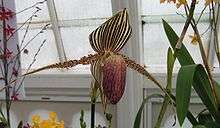Paphiopedilum rothschildianum
| Paphiopedilum rothschildianum | |
|---|---|
 | |
| Scientific classification | |
| Kingdom: | Plantae |
| (unranked): | Angiosperms |
| (unranked): | Monocots |
| Order: | Asparagales |
| Family: | Orchidaceae |
| Genus: | Paphiopedilum |
| Species: | P. rothschildianum |
| Binomial name | |
| Paphiopedilum rothschildianum (Rchb.f.) Stein 1888 | |
| Synonyms | |
Paphiopedilum rothschildianum, commonly known as the Gold of Kinabalu orchid or Rothshild's slipper orchid, is a large sized clear-leafed species of orchid. It blooms with a tall inflorescence with up to six, large flowers. It is unique in the Corypetalum group by holding its petals almost horizontally, giving the flower a very distinctive appearance. The peak flowering period is from April to May.
Distribution
Paphiopedilum rothschildianum (also called 'Rothschild's slipper orchid', after its discoverer) is found in the rainforests around Mount Kinabalu in northern Borneo, at elevations from 500 to 1200 meters above the sea. It commonly grows as a terrestrial in ultramafic soil but is also found growing as a lithophyte in leaf-litter on ultramafic cliffs, usually near a river.
Reproduction
The flower has a green and red spotted petal, which attracts any parasitic flies that think it is a crowd of the aphids they lay eggs on. As they try to do so, the flies brush against the stigma, releasing any previously collected pollen, and then getting some more from the anther.
References
Further reading
- Braem, G. J.; Baker, Charles O.; Baker, Margaret L. (1998). The Genus Paphiopedilum: Natural History and Cultivation. 1. Kissimmee, Florida: Botanical Publishers.
- Rodrigues, K. F.; Kumar, S. V. (2008). "Isolation and characterization of 24 microsatellite loci in Paphiopedilum rothschildianum, an endangered slipper orchid". Conservation Genetics. 10 (1): 127–30. doi:10.1007/s10592-008-9533-1.
- Chyuam-Yih, NG; Saleh, NM; Zaman, FQ (2010). "In vitro multiplication of the rare and endangered slipper orchid, Paphiopedilum rothschildianum (Orchidaceae)". African Journal of Biotechnology. 9 (14).
- Nash, Ned (June 1985). "Paphiopedilum Culture for Beginners — 3" (PDF). American Orchid Society Bulletin. 54 (6).
External links
-
 Media related to Rotschild's slipper orchid (Paphiopedilum rothschildianum) at Wikimedia Commons
Media related to Rotschild's slipper orchid (Paphiopedilum rothschildianum) at Wikimedia Commons -
 Data related to Rotschild's slipper orchid (Paphiopedilum rothschildianum) at Wikispecies
Data related to Rotschild's slipper orchid (Paphiopedilum rothschildianum) at Wikispecies - http://www.orchidspecies.com/paphrothchildianum.htm